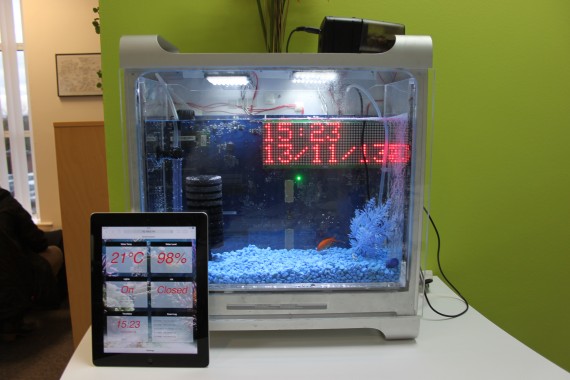
People have been converting their old Power Macs and Mac G5s into fish tanks for a few years now, but [Hayden’s] Internet-enabled tank is probably the most awesome ever crammed into an aquarium along with the water and the fish—and we’ve seen some fascinating builds this summer. After gutting the G5 and covering the basic acrylic work, [Hayden] started piling on the electronics: a webcam, timed LED lighting, an LCD for status readouts, filter and bubble control via a servo, an ultrasonic sensor to measure water levels, thermometer, scrolling matrix display, an automatic feeding mechanism, and more. He even snuck in the G5’s old mainboard solely for a cool backdrop.
The build uses both a Raspberry Pi and an Arduino Mega, which sit underneath the tank at the base. The Pi provides a web interface written in PHP and jQuery, which presents you with the tank’s status and allows changes to some settings. Nearly every component received some form of modification. [Hayden] stripped the webcam of its case and replaced the enclosure with a piece of acrylic and a mountain of silicone, making it both waterproof and slim enough to fit in the appropriate spot. Though he decided to stick with an Amazon-bought Eheim fish feeder, he disabled the unit’s autofeed timer and tapped in to the manual “feed” button to integrate it into his own system.
It’d take half of the front page to explain the rest of this thing. We’ve decided to let the aquarium tell you the rest of its features in the video below. Yeah…it can talk.















He used a perfectly good Bitfenix Prodigy for an aquarium? Oh wait…nope…it’s just a mac. Carry on.
I love the look of that thing! :-)
I feel bad for the fish. I wonder if the goldfish will outgrow that tiny tank in a short amount of time, or be permanently stunted by the toxins leaching out of that old motherboard…
It will take many, many years for the tank to be too small for the fish. And the chances of a feeder goldfish living that long are slim to none.
This would make a cool nano reef tank.
The motherboard is also behind the tank, not in it with the fish. Just for looks, no worries about getting it wet or hurting fish.
The welfare of the fish came first in this build.
It will be transported to a larger tank well before it outgrows this one.
You’re not the first person to mention the submersed motherboard which is awesome! Because the board is actually behind the tank, there are no electronics beside the temperature sensor on the water, its just an illusion :)
Hayden
A well done illusion! Had me fooled.
I’m glad to hear that the fish will have a larger home when needed.
The matrix display is really pretty ugly. Why not just put a flat panel behind the tank and run it off a raspi or beagle bone?
Stick a monitor behind the tank, use a camera to track the fish, and let the fish interact with the screen.
Have it browse youtube, use it’s movements to walk a Markov chain and generate text for the comments. See how long it takes before people find out they’ve been trolled by a fish.
APPLE products as they should be… just good enough for the little fishes.
Overpriced Aluminum re-cycled cans… ;^)
APPLE zombies by-product… what more is their to say…
It sure isn’t a “green solution” either.
I’m just saying……
Good grief all the haters,
They are just jealous that no one likes the look of their old
computer enough to repurpose it into something they want to keep
on display.
Seriously I have never seen anyone use a PC case for this kind of project.
Love the fact of repurposing instead of going into a land fill.
Doesn’t that break Apple’s TOS? You are using the computer for something it wasn’t designed for.
Cool tank.
In a Vo-Tech computer lab, I saw what looked like a fully operating computer in a fish tank. It was fully operating, but instead of water it used mineral oil to cool the components. And the oil is non-conductive and non-corrosive. No fish though :-(
Stephen Hawking lives in a fish tank?
I’m curious how the arduino serial code will hold up through tty-over-usb bumps and hiccups, usb hub and all. I have a wood-fired water heater with a web interface that (at first) was using a RPi + arduino uno, and firmata as the arduino firmware. The serial communication was so unreliable that I finally added an ethernet shield, rewrote the whole thing in arduino, and moved the RPi on to better things.
I think Hayden’s choice of using a 9600 baud serial speed is a wise choice–firmata runs at 57k by default which I think makes it prone to noise. I did consider tapping the RPi’s ttyAMA0 (on the gpio header) straight to the arduino’s rx/tx connections, but tossing the ethernet shield on there was just too easy and it freed up my RPi.
FIrst IP Out : payload=”Papa!”; first IN : payload=”Nemo!”
Like the idea, but the fish you chose couldn’t be more wrong. Goldfish need at least a group of five fish and they need a minimum tank of a 100 gallons. They are messy fish and they need GOOD filtration, air bubble run filters are not good filters.